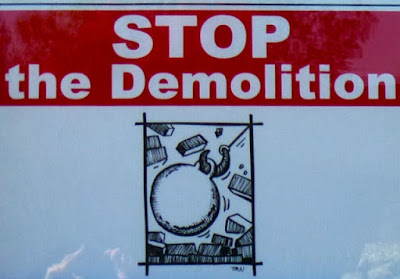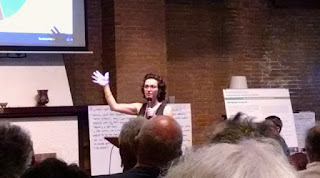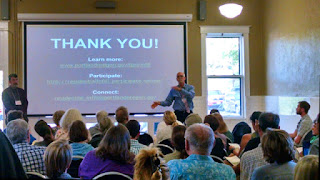Here come the dog days of summer. And here comes a huge reason to rouse out of that chaise lounge, starting tomorrow (Tuesday) night.
At last the
recommendations by way of the Residential Infill Project move to the fore in a series of open houses to be staged this summer around the city (see banner above for details). The first open house, at the Multnomah Arts Center in mid-June, drew so many activists demanding to be heard that organizers had to change the event format away from neutralizing small-group discussion to an open Q&A.
This is the time to stand up for yourselves and your neighborhood. Entrenched and well-financed players stand ready to increase demolitions across the city.
 |
| That's why we're here. |
It's a shame because the Residential Infill Project—an idea that came out of United Neighborhoods for Reform's
resolution—engaged some people who are deeply committed to improving new construction while also protecting affordable housing in the neighborhoods. The Residential Infill Project slogged through long evenings not without some drama—the rep from the Home Builders Association threw a tantrum and walked out of one event, and someone in the pro-developer crowd once called some of the other members "racist" (which really stings given the mass exodus of diverse people and seniors from the close-in neighborhoods under current demo-favorable city policies).
A few of the recommendations tackle the original intent for the effort, providing new guidelines for scale such as height and volume of new homes. If they work, they could put those McMansions on a diet and, better, reduce the financial incentive of knocking down a modestly sized home that was accessible to many more buyers. Living smaller is a great, green way to live, too.
However, the vast majority of the rest of the recommendations (starting on Page 12 of the
Bureau of Planning doc) amount to a rezoning of existing neighborhoods that puts thousands more homes in the cross-hairs. Is your neighborhood a profit center, or is it a place to live? As one activist attendee of a meeting last spring with incoming Mayor Ted Wheeler noted, "Once the market starts to dictate a community, it ceases to be a community."
The 43 neighborhood associations listed at right already have indicated they want more of a say in their future. Developers and city staff can trust us Portlanders—after all, didn't we lay the groundwork for some years of astonishing profits for (usually out-of-town) business interests? We are up to the task of self-determination, and—given the hounds at the door and what they have in mind for us—we're going to need it.
 |
Heather Flint Chatto talks about tools that came out of the
forward-thinking, problem-solving Division Design Initiative
at last week's Citylove event. |
Citylovers get serious
At Friday's gathering called
Citylove, activists fighting
demolition along Southeast Belmont, monitoring the city's Mixed Use Zone activity, and dispelling density myths with sound number-crunching countered the idea that it's necessary to raze Portland to rise it.
KGW, a local station, dug in and showed that
Portland has plenty of vacant, buildable land ripe for development without demolishing a thing.
Moss doesn't lie
Fallout from hazardous materials remains one of the biggest, avoidable impacts of demolition. The
Forest Service recently reported that moss growing in Kenton tested off the charts for lead, with no glass factories nearby to blame. Instead, as noted in the update to the
Portland Mercury story, all signs point to demolition of a small house that occurred across the street as the source for the dispersed lead. (The actual data: The Kenton sample tested at 129 milligrams of lead per kg of dried moss; other readings of moss citywide tested between 2 and 6 mg/kg.)
Hazardous-materials fallout is
important even if, as indicated by the Bureau of Development Services's Nancy Thorington, head of a city subcommittee tasked with managing demolition impacts, the city is far more worried about provoking developers' lawyers than it is about permanent health effects and environmental toxicity among Portland's people. That may change given the
litigation already
starting after moss samples registering high in toxins early this year led scientists to largely unregulated emissions from glass factories.
We are grateful for the continuing interest and exposure by media outlets and other fact-seekers on all these issues.
At the grass-roots, supporters of the antidemolition effort keep multiplying, and are increasingly anxious to bring about more beneficial development that becomes an asset to the neighborhood.




























